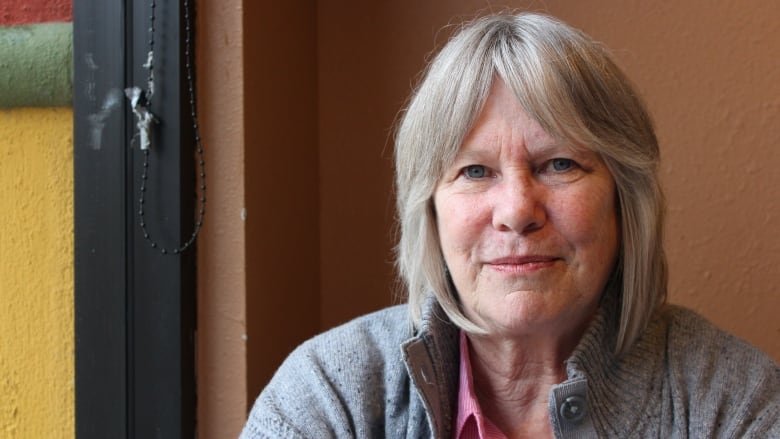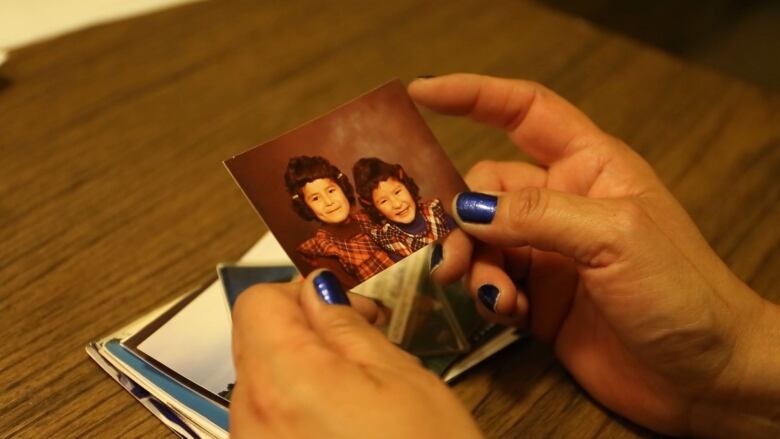'Naive but a good intention' adoptive parents grapple with fallout of Sixties Scoop
Parents who adopted Indigenous children said they were not given key details about culture, family history

The CBC podcast FindingCleo follows a family's search for CleoSemaganisNicotine, who was adopted out of her Saskatchewan First Nations community and sent to live in the U.S. 44 years ago during what became known as the Sixties Scoop. In this week's episodes, host Connie Walker pursues a leadthat takes her to a cemetery in New Jersey and shares the shocking news of what she finds there with Cleo'ssiblings, who were all separated andscattered across the U.S and Canadain the Sixties Scoop. Read more about theSemaganissiblings and the families who adopted them in the story below.
- Subscribe to the podcastoniTunesorlisten here
- Look for new episodes every Wednesday
Over the course of a few months in 1974, Jeff and Kay and their three young sons grew from a family of five to a family of seven.
Not long before, they had contacted a Children's Aid Society in Ontario to inquire about adopting a little girl.
"I think it was just perhaps naive but a good intention to do something positive," Kay said.
Soon they were on a plane from Toronto to North Battleford, Sask., to meet two sisters who were staying with a foster family there. The older girl was seven; the younger girl was six.

They arrived to find two little girls sitting on the couch with their hair permed into little curls. They were wearing matching dresses, Jeff recalled.
"They had already been prompted to call us Mom and Dad. Mommy and Daddy," Kay said.
The girls were allowed to spend the night at a hotel with Jeff and Kay the first weekend they met.
CBC has agreed not to use the family's last names to protect the sisters' identity.
They are known as April and Annette,two of six Semaganis siblings from Little Pine First Nation, about 200 km northwest of Saskatoon, who were apprehended by child welfare authorities in the early 1970s, made wards of the province, and adopted into non-Indigenous families in Canada and the U.S. during what is now known as the Sixties Scoop.
The siblings have been searching for their sisterCleo for decades, and last year, CBC News joined the search, and made their questthe focus of a CBC News investigation and podcast.
LISTEN to Episode 4: The search for Cleo leads to a cemetery in New Jersey:

What they knew
There is limited research on the families who adopted or who were long-term foster parents to Indigenous children in government care during the Sixties Scoopperiod including whattheir motivations were, any training they were given and what they might have known about Indigenous culture and traditions.

Jeff and Kay said they were eager to welcome Annette and April into their new family, but social workers did not reveal much information about them. The adoptive parents knew virtually nothing about their new daughters' culture, family history or experiences.
In retrospect, the entire process moved too fast,Kay said.
"It moved without any support or idea about what that would really mean to those little girls," she said.
Kay said they were provided with a background page on each child.
"And as I recall, the paragraphs were similar. Little history of the siblings, little history of their mom ... 'Happy child, doing well in school' ... but no detail."
It was only after both girls ran away from home around the time they each turned 13 that Kay and Jeff realized how disturbed and turbulent their early years had been.
Read the other features in the Finding Cleo series:
- CBC podcast solves decades-old mystery of Saskatchewan girl lost in Sixties Scoop
- Creator of Sixties Scoop program says it wasn't meant to place kids with white families
- How siblings of lost Saskatchewan girl made peace with their loss
- OPINION | The Sixties Scoop tried to extinguish our culture and our spirit. It failed
"Thinking back, I don't know how the kids were in as good a shape as they were given what they'dbeen through," Jeff said. "But it all just kind of was held back, I guess, and finally didn't come out until they were in their teens."
As the sisters grew older, they began sharing stories with Kay about their time in foster care in Saskatchewan.
"The stories that I heard were that they were both sexually and physically abused in their foster homes," she said.
After running away, Annette and April spent time livingon the streets of Toronto. April suffered psychological problems. Both girls struggled with substance abuse and spent time in youth correctional facilities.
As adults, they were close to their adoptive parents, and April remains so. Annette died at age 40 of cirrhosis of the liver.

After Annette died, Jefftracked down the girls' biological mother, Lillian. He noticed that she shared April's gentle nature.
And despite his love for his adoptive daughters, he came to a startling conclusion.
"I'm sure those kids would have been much better off with Lillian in spite of all the problems she hadif there had been a way for that to continue," he said.
'If it wasn't for her ... I'd be dead or in jail'
The sisters' older brother, Johnny Semaganis, was adopted by an American family in Pennsylvania in 1975. He said he was expected to work as a farmhand, lived in a tent on the property in the summer and later in a building that was separate from the family's house, as well as two Native American boys.
Johnny ran away and ended up withBill and Kay Henry, foster parents he credits with saving his life.
"Kay she knew I didn't have anybody down here, and she kept me," he said. "I guess if it wasn't for her ... I'd be dead or in jail."
Kay Henry said she was given little information about Johnny before he came to live with them.
"I just remember them telling me that they had had a child that had put himself on the streets because he was in a bad situation and so he was coming to our house." she said. "There he came. And he's been one of the best. Believe me I wouldn't trade him for the world."

The Henrys had a lot of experience as parents. They have three biological sons, adopted nine children and fostered more than 130 over 30 years children of different races and cultural backgrounds. Johnny is their only Indigenous child.
"I do love him 100 per cent. He's my son," Kay Henry said. "I've done it both ways. I've had homemade ones, and I had adopted ones. And if you love them, there is no difference."
Johnny remains close to the Henrys. He lives nearby and sees them frequently. He said he has no interest in returning home to Little Pine perhaps not even to visit. He said the policies of the 60s and 70s worked.
"I have been assimilated," Johnny said in a wry tone.
LISTEN to Episode 5: Cleo's siblings learn where but not how she died:

Broken adoptions, runaways
Academics and advocates for Sixties Scoop adoptees have varying estimates of the number of adoptions that broke down, in which the adoptees and adoptive families are now estranged. But there is consensus that the proportion is at least 50 per cent, which is greater than in the cases ofother cross-racial adoptions.
Researchers have attributed the higher failure rate to the unique experience Indigenous children have in Canada encountering racist stereotypes and what they call the lack of support for white parents to be able to act as a buffer for their children.
Christine Cameron, another of the Semaganis siblings who spent decades searching for Cleo, puts her own experience into thecategory of unsuccessful adoptions. She doesn't talk to her adoptive family anymore.
"I'm not saying they're horrible," she said. "I'm just saying that some of their attitudes and world views about native people didn't really jibe with who was living in their house."
- Meet the people in Finding Cleo
- LISTEN |Missing & Murdered Season 1: Who killedAlberta Williams?
- Search the databse of unsolved cases of Indigenous women and girls
Cameron's adoptive father is Scottish. She grew up in a community in Saskatchewanof people of Icelandic and Ukrainian backgrounds. Just like many Sixties Scoop survivors, she said she felt isolated and different from those around her.
"Growing up, my grandmother used to say, 'When we adopted you, you became a white person,'" she said. "That might have been how my family perceived me, but that's not how society saw me."
Cameron recalled her adoptive mother being blunt about why they brought her home.
"She said if they waited for a little white girl, they [would] be waiting for five or six years, but they could have me right away," she said. "They told me that they would never have to pay for my education, and that's why they adopted me."

Her sister Cleo, who was eventually adopted by an American family in New Jersey,longed to go back home to Saskatchewan and tried to run away from her adoptive family.
Prior to their adoptions in themid-1970s, Cleo and Johnny were placed together with the same foster family in the villageofMedstead, Sask. theMiszaniecs,who say they fostered 25 to 30 Indigenous children over the years.
TheMiszaniecssay they received notrainingto be foster parents at the time and had little to no notice when foster children would be arrivingor leaving.
And only when contacted byCBCNews about Cleo and Johnny did they begin learning about the SixtiesScoop.
- LISTEN toMissing & Murdered: Finding Cleo
- Subscribe to the podcastoniTunes












_(720p).jpg)


 OFFICIAL HD MUSIC VIDEO.jpg)
.jpg)



























































































